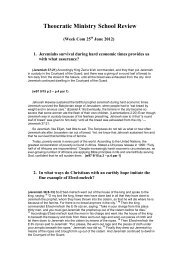1964 Awake! - Theocratic Collector.com
1964 Awake! - Theocratic Collector.com
1964 Awake! - Theocratic Collector.com
You also want an ePaper? Increase the reach of your titles
YUMPU automatically turns print PDFs into web optimized ePapers that Google loves.
NON REASONING<br />
TRAVELERS<br />
BUT<br />
WITH the <strong>com</strong>ing of fall,<br />
millions of birds in the<br />
Northern Hemisphere take to<br />
the wing and head south in a<br />
mass migration that carries<br />
some of them many thousands<br />
of miles. High-flying ducks and<br />
geese pass in formation over city<br />
after city without the benefit of radio<br />
beacons and other electronic<br />
guidance systems that keep human<br />
air travelers from be<strong>com</strong>ing lost. At<br />
lower altitudes clouds of smaller<br />
birds pass by with equal disregard<br />
for knowledge about the science of<br />
navigation. How is it possible for these<br />
nonreasoning creatures to navigate accurately<br />
over great distances while intelligent<br />
humans are unable to do it without<br />
the aid of precision-made instruments?<br />
The songbirds known as warblers live<br />
in north European countries during the<br />
spring and summer, but in September they<br />
begin heading south. Their destination is<br />
Africa, including its southern part. Although<br />
this is a trip of several thousand<br />
miles, they navigate it with surprising accuracy.<br />
Unlike ducks, the warblers do not<br />
make the trip in groups that follow leaders.<br />
Each is an individual traveler.<br />
Possibly the longest route that is flown<br />
by migrating birds is that followed by<br />
Arctic terns. Every year they make a<br />
round trip between the Arctic and the Antarctic,<br />
with some flying a distance of about<br />
25,000 miles. With equally good navigational<br />
ability, the bristle-thighed curlew<br />
flies 6,000 miles from Alaska to Tahiti in<br />
a migratory flight. For more than 2,000<br />
miles of this trip, between Alaska and the<br />
AUGUST 22, <strong>1964</strong><br />
Hawaiian Islands, the birds must fly nonstop<br />
over open ocean with no landmarks to<br />
help them to find their way.<br />
Not even a previous knowledge of a<br />
route is necessary for migratory birds to<br />
fly accurately to their destination, although<br />
that destination may be nothing<br />
more than a speck of land surrounded by<br />
hundreds of miles of water. Young birds<br />
making the trip for the first time manifest<br />
the same ability as the older birds for<br />
navigating accurately.<br />
In a test of a bird's ability to find its<br />
way over unknown territory, some investigators<br />
sent a Manx shearwater from England<br />
to the United States by plane. There<br />
it was released. Within twelve days it was<br />
back in its nest on the west coast of England,<br />
having flown more than 3,000 miles<br />
over an unfamiliar route, Certain types of<br />
pigeons manifest a somewhat similar homing<br />
ability. When released in unfamiliar<br />
territory, they will circle briefly and then<br />
head off in the right direction for their<br />
lofts.<br />
9




